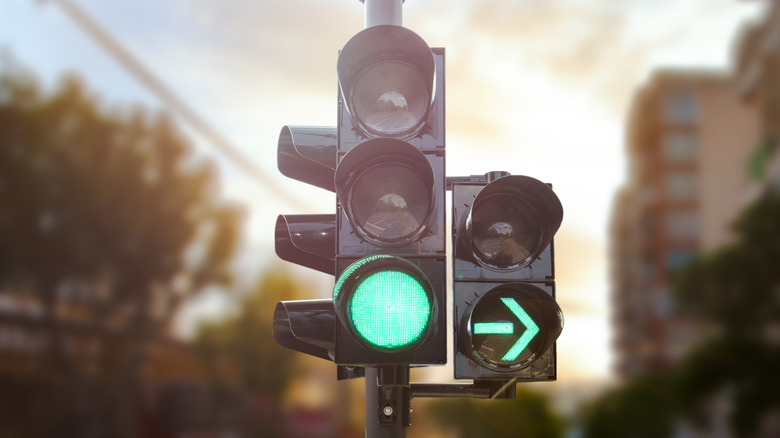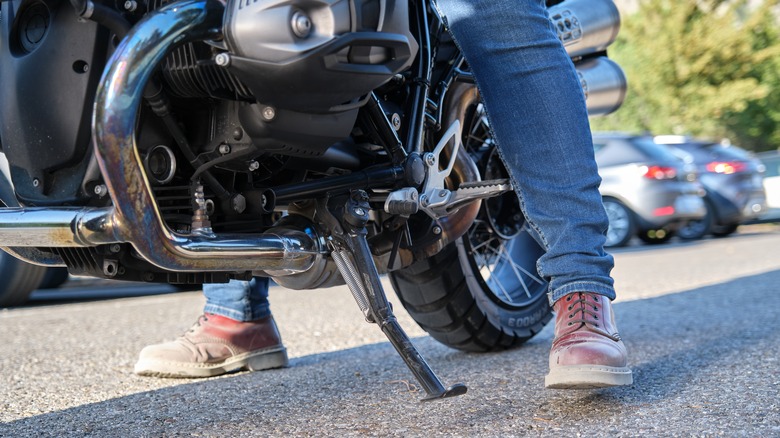The Reason Motorcycles Get Stuck At Traffic Lights
Motorcyclists are some of the freest drivers on the road. They get to experience the thrill of movement without being impeded by doors, windows, and other elements that box drivers into a car or truck. Motorcycles allow for powerful acceleration, tight turning, and a driving experience that places enjoyment of the road at the forefront. But motorcycles must contend with a unique problem set that car owners simply never have to think about.
Motorcycles often have trouble with stale red lights during low traffic periods, particularly late at night. When other motorists aren't on the roadways, a traffic light can become immensely stubborn, leaving a motorcycle rider waiting indefinitely for the signal to change. This happens because red light sensors make use of magnetic field generation (using the vehicles waiting at the intersection as a source), but motorcycles are uniquely sized and can cause problems in creating the loop required to shift the signal if no other vehicles come along to help out the driver. Many states have passed laws that give motorcyclists the ability to legally run the light in the event of a static red (via Motor Biscuit), but this isn't a viable solution in every jurisdiction.
This means that motorcyclists everywhere need to understand the mechanics of red lights and internalize strategies to force the light to change faster to continue on their way safely and quickly.
Red light detection can be all about location
The first thing that a motorcyclist needs to know about red lights (and how to turn them green faster) is how the detection process works in the first place. While some intersections are governed by simple timers, these aren't very common anymore; instead, actuated systems allow for smart traffic control (via Practical Engineering). What's more, a timed intersection won't create the same kind of stalemate for a motorcyclist, meaning they aren't problems here. The majority of modern traffic signals make use of an induction loop to generate a magnetic field that is picked up by a nearby sensor, according to How Stuff Works. Stopping on top of the coil alters the existing magnetic field and allows the detection equipment to pick up on the fact that a vehicle is waiting.
Because motorcycles are much smaller than a typical car, drivers can experience difficulties in generating the field required to trigger action from the control unit. One thing that can make a difference is the location of your stop while driving a motorcycle.
The loop placed under the roadway is visually striking, with cut marks in the pavement that indicate where the wiring was laid. RevZilla notes that parking your vehicle directly over those cutouts will give you the best chance of triggering the signal without delay.
Try the kickstand for direct contact with the detection circuit
If bike placement doesn't fix your red light issue, another option is the use of your kickstand or side stand. These are made of dense metals in order to support the weight of the motorcycle. As a result, direct contact with the coil can act as a powerful conduction element that may just be enough to signal the essential change in the magnetic field. Motorcycle Forum users note that success can often be found with this method of direct contact with the coil cut lines in the pavement.
The metal contact works as a direct connection with the system's magnetic loop. When the presence of your vehicle alone doesn't provide enough mass to create the change in magnetic fields above and below the surface of the pavement, this additional consideration can provide the impetus required in a pinch. This is a simple solution, but one that appears to work impressively well.
Raise the issue with your local authority as a civic service
If you find that a particular light (or lights) in your community continue to provide hassle and heartache for you and your motorcycle commute or favorite hobby ride, an important step that you can take to fix the problem for good is the act of raising the issue with your local government. Local authorities are responsible for a great many tasks and regulatory actions in their communities, and one of those responsibilities is the maintenance of traffic lights. Red light sensors are set on typical sensitivity levels, but this doesn't mean that they are always perfect. As well, the Department of Transportation has published volumes of research on optimal sensitivity and detection node shape, meaning that this task is continually being studied and improved upon for the greatest road user benefit.
Writing to your local government, calling the government offices, or dropping by for a visit when you have some time to spare can help fix the problem for good to make your daily ride more enjoyable, as well as the commute for any other motorcyclist in your area that uses the same roadways. Raising the issue can act as the first step when trying to initiate a review of local light settings. A few tweaks to sensitivity can immediately fix this issue in the detection nodes for motorcyclists, so it's often a good idea to contact government agencies overseeing road safety for a permanent fix to this nagging problem.



